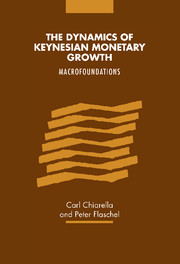Book contents
- Frontmatter
- Contents
- List of figures
- Foreword by Richard H. Day
- Preface
- Acknowledgments
- Notation
- General introduction
- 1 Traditional monetary growth dynamics
- 2 Tobinian monetary growth: the (neo)Classical point of departure
- 3 Keynes–Wicksell models of monetary growth: synthesizing Keynes into the Classics
- 4 Keynesian monetary growth: the missing prototype
- 5 Smooth factor substitution: a secondary and confused issue
- 6 Keynesian monetary growth: the working model
- 7 The road ahead
- References
- Author index
- Subject index
2 - Tobinian monetary growth: the (neo)Classical point of departure
Published online by Cambridge University Press: 22 September 2009
- Frontmatter
- Contents
- List of figures
- Foreword by Richard H. Day
- Preface
- Acknowledgments
- Notation
- General introduction
- 1 Traditional monetary growth dynamics
- 2 Tobinian monetary growth: the (neo)Classical point of departure
- 3 Keynes–Wicksell models of monetary growth: synthesizing Keynes into the Classics
- 4 Keynesian monetary growth: the missing prototype
- 5 Smooth factor substitution: a secondary and confused issue
- 6 Keynesian monetary growth: the working model
- 7 The road ahead
- References
- Author index
- Subject index
Summary
In this chapter we introduce a Classical reformulation of the Tobin (1965) model of monetary growth, with fixed proportions in production and Classical saving habits. Section 2.1 presents the standard full equilibrium version of this model type, while section 2.2 considers the money-market disequilibrium extension of it which was extensively studied in the seventies and the early eighties. By means of these reformulations of models of the literature we shall recapitulate some of the important results obtained for this monetary growth model type concerning non-superneutrality of the steady state and the pure Tobin effect, instability of the steady state due to what we call the Cagan effect in the money demand function, and certain new limit cycle results which can be built on such local instability.
The chapter then proceeds, in section 2.3, by providing some new extensions to these Tobin type models. First, since the Tobin models rely on an elaborate form of Say's Law for the market for goods, it is very easy and natural to extend the model to labor market disequilibrium. This disequilibrium is here due solely to capital shortage or abundance and is completely decoupled from the situation on the market for goods. This extension, which basically reformulates the wage–price sector of the model, generally increases the dynamic dimension of the model by two to four, since there is now room for disequilibrium fluctuations of the real wage as well as fluctuations in the growth rate of the capital stock.
- Type
- Chapter
- Information
- The Dynamics of Keynesian Monetary GrowthMacro Foundations, pp. 69 - 126Publisher: Cambridge University PressPrint publication year: 2000



